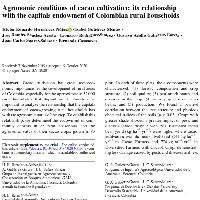Resumen
- Cacao cultivation has great socioeconomic importance for the development of rural areas of Colombia, especially for the approximately 52,000 rural households that depend on it. Therefore, is important to analyze the relationship that the capitals endowment of cacao-growing rural households has with the agronomic status of the crop. To establish this relationship, we determined the endowment of community capitals in 22 rural households and the agronomic status of their cacao crops, grown in 83 plots. In each of these plots, these components were characterized: (1) floristic composition and crop structure; (2) soil quality; (3) pest attack status and diseases in the crop; (4) sensory quality of cacao beans, and (5) production. We found a positive correlation between the tree structure and physicochemical indices of the soils (p\0.05). Crops withgreater shade showed a greater impact of pests and diseases (shade range 2.2–85.7%). Estimated cacao bean yield (kg ha-1 yr-1) were higher where cacao cultivation was the main livelihood (961 kg ha-1 - yr-1 in Cacao Farmers and 774 kg ha-1 yr-1 in Diversified Farmers with Cacao). Crops demonstrating less damage caused by pests and diseases and less diverse tree structures obtained a higher cacao bean yield (kg ha-1 yr-1). Households with greater knowledge, experience and interaction with institutions that offer training, had more diverse tree structures and better soils physicochemical conditions. Households with greater capitals endowment had better agronomic conditions in cacao cultivation and had crops that generated additional products.
